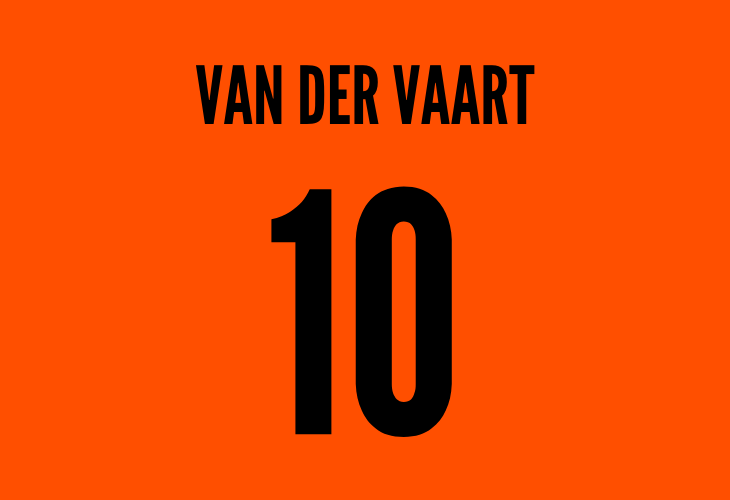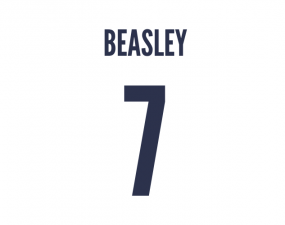Player Profile: Rafael van der Vaart
Date of Birth: 11/02/1983
Height: 5 ft 9 in
Position: Attacking midfielder
National Team: Netherlands
International Caps: 109
International Goals: 25
Club Career
Often compared to the great Johan Cruyff, Rafael van der Vaart was blessed with great skill, composure and vision. Everything you’d expect from a product of the Ajax academy. On his day he was up there with the best in the world. Van der Vaart enjoyed a playing career spanning 18 years, during which he played for some of Europe’s biggest sides.
Born in Heemskerk to a Dutch father and Spanish mother, Van der Vaart grew up on a trailer park where he learned the beautiful art of football. Aged ten he joined the famous Ajax Academy and rose through the ranks with future Holland teammates Wesley Sneijder and John Heitinga.
Van der Vaart spent seven years with the academy before making his first-team debut aged 17 during the 1999/2000 campaign. But he’d have to wait until the following season for his next appearance. It was worth the wait though. Switching to a more attacking role in 2000/01 campaign, he made 27 league appearances scoring seven goals.
By the start of the 2001/02 season Van der Vaart was a regular first-team player and big things were expected of him. He was scoring and creating goals for fun before suffering a serious knee injury which resulted in several months on the sidelines. This was a major setback for the Dutchman, but he returned to action later that season.
Unfortunately, his return was short-lived as he re-injured the same knee. This time though he’d need surgery and as a result missed the remainder of the season as Ajax went on to be Eredivisie and Dutch Cup champions. His excellent form earlier in the season earned him the Netherlands’ Talent of The Year award.
Van der Vaart was once again limited to just 21 league appearances during the 2002/03 campaign because of injury. But he returned to score a decisive goal against Lyon in the Champions League. Despite his injury troubles, Van der Vaart scored 22 goals in all competitions that season. His performances for the Amsterdam based club would see him win the inaugural Golden Boy award, for the best young player in European football.
He was fast becoming an influential figure within the Ajax side, and as a result was heavily criticised for his poor performances at the start of the 2003/04 campaign. Van der Vaart admitted to being overweight early on in the season, but as the season progressed his form improved dramatically. Once he found his feet, the midfielder played a pivotal role in yet another Ajax league title.
The following season Van der Vaart was handed the captain’s armband by then manager Ronald Koeman. However, things soon turned sour. After selling Zlatan Ibrahimović to Juventus, Koeman moved Van der Vaart to centre forward. A decision that didn’t go down well. Van der Vaart was unhappy with being played out of position and following a disagreement with Koeman he was stripped of the captain’s armband in December 2004.
Earlier that season, in a league game against ADO Den Haag, play was halted due to abusive chant directed at Van der Vaart’s other half. The incident, as well as his ongoing injury problems, ended up resulting in the Dutchman leaving his boyhood club.
At this point in his career, Van der Vaart was highly sought after so he wasn’t short on options. He had been strongly linked with Milan but in the end, signed for Hamburg. The move raised eyebrows across Europe, with Johan Cruyff saying “I don’t know what to say about it or what Rafael van der Vaart is doing in Hamburg.” Despite the criticism, he finished his first season in Germany as Hamburg’s top scorer with 16 goals in all competitions and helped the club win the Intertoto Cup.
Van der Vaart was named club captain at the start of the 2006/07 season but was once again sidelined due to a few niggling injuries. He returned towards the end of the season, helping the club win the Intertoto Cup for a second consecutive time.
The 2007/08 season would prove to be his last in Germany, for a few years anyway. He made 29 league appearances scoring 12 goals as Hamburg finished 4th in the Bundesliga. Speculation regarding his future was rife throughout the season and in August 2008 the inevitable happened, Van der Vaart left the club.
Atletico Madrid, Juventus, Chelsea and Valencia were all interested in signing the Dutchman, but it was Real Madrid who acquired his services for €13 million. He marked his league debut with a goal as Real Madrid beat Numancia 4-3, before scoring his first career hat-trick against Sporting de Gijon just a few weeks later.
Van der Vaart’s excellent form for both club and country in 2008 resulted in him being nominated for the Ballon d’Or. Despite his bright start to life in Spain, Van der Vaart soon found himself being used as an impact sub. Rumours suggested the Dutchman had fallen out with then-manager Juande Ramos, which was the reason behind the lack of game time. Subsequently, Van der Vaart’s future at the Bernabeu was already in doubt.
The following season Real Madrid were under the leadership of Manuel Pellegrini. Initially, it appeared that Van der Vaart was not part of the new manager’s plans. However, when fellow countrymen Wesley Sneijder, Arjen Robben and Klaas-Jan Huntelaar left the club, and Kaka suffered a serious injury, van der Vaart was given his chance. And as always, he delivered. The midfielder scored seven goals in 31 appearances in all competitions for Los Blancos, but it wasn’t enough for him to remain at the club.
On 31st August 2010, two hours before the transfer window slammed shut, Tottenham had an £8 million bid for the midfielder accepted by Real Madrid. A technical issue, though, almost scuppered the deal as Spurs needed an extension granted by the Premier League to get the signing over the line. It was well worth the hassle.
In his first season in English football, Van der Vaart finished the campaign as Tottenham’s leading goalscorer with 13 Premier League goals. Two of those goals came against North London rivals Arsenal in a 3-3 draw at White Hart Lane resulting in him fast becoming a fan favourite. He also provided the most assists that season with nine.
Van der Vaart started the 2011/12 season in red-hot form, scoring six league goals in five games. In doing so, he equalled a club record of scoring in five consecutive Premier League games, a record he shares with club legends Robbie Keane and Teddy Sheringham. Later that season Van der Vaart was on the pitch when Bolton Wanderers midfielder Fabrice Muamba sufferer a cardiac arrest. He would later describe this moment as “the absolute low in my football career.”
In the summer of 2012, Spurs splashed the cash on several signings including Mousa Dembele, Clint Dempsey and Gylfi Sigurdsson. Van der Vaart found himself surplus to requirements at White Hart Lane and before the transfer window shut, he sealed a move back to Hamburg in Germany.
Throughout the next three seasons, the Dutchman made 78 league appearances scoring 16 goals. But his performances were nowhere near the levels he’d reached during his first spell at the club. As a result, the German side decided not to extend his contract.
After leaving HSV, Van der Vaart returned to Spain where he signed for newly promoted Real Betis. During his one year stay, he made just seven league appearances with injuries once again causing him to miss the majority of the season.
Van der Vaart played out the last three years of his career in Denmark. He spent two years at Midtjylland and a season at Esbjerg fB, making a combined total of 20 league appearances in three seasons. On 4th November 2018 the inevitable happened, Rafael van der Vaart announced he was retiring from professional football. He ended his career with 538 appearances and 171 goals.
International Career
Rafael van der Vaart made 109 appearances for the Netherlands scoring 25 goals in total. During his 12-year international career, he represented his country at two World Cups and three European Championships.
He made his senior debut at the age of 18 after representing Holland at U17, U19 and U21 levels. His first taste of tournament football was at Euro 2004. Then-manager Dick Advocaat opted for a formation that didn’t suit Van der Vaart’s style; therefore, the midfielder would only play a bit-part role. Two years later at the 2006 World Cup injuries once again limited Van der Vaart’s game time, much to his frustration.
Van der Vaart was one of Holland’s key players at Euro 2008, but he could do nothing to prevent them from being dumped out of the competition by Russia. Two years later, Van der Vaart was part of the Dutch squad that lost to Spain in the final of the 2010 World Cup in South Africa.
Euro 2012 would turn out to be the midfielders last international tournament, and it ended in disappointment as Holland were eliminated from the competition after losing all three group games.
Where is Rafael van der Vaart doing now?
In 2019, Van der Vaart surprised everyone by turning pro at darts. He joined the famous British Darts Organisation and won his first-ever match 4-2 at the Denmark Open. He was later beaten 4-0 by Mogens Christensen in the next round.
Did you know? Interesting facts about Rafael van der Vaart
– VVD is going out with Danish handball player Estavana Polman. This is one of the main reasons he moved to Denmark in the twilight of his career.
–




